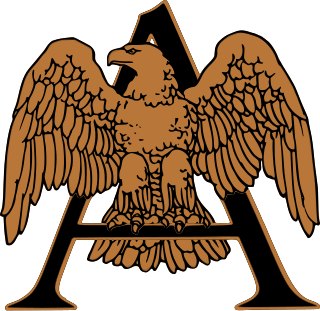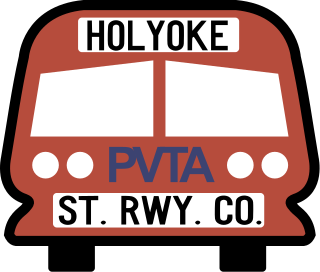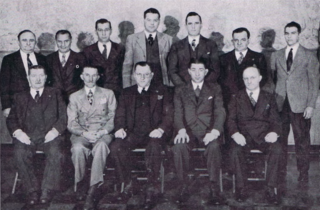
Holyoke is a city in Hampden County, Massachusetts, United States, that lies between the western bank of the Connecticut River and the Mount Tom Range. As of the 2020 census, the city had a population of 38,247. Located 8 miles (13 km) north of Springfield, Holyoke is part of the Springfield Metropolitan Area, one of the two distinct metropolitan areas in Massachusetts.

American Pad & Paper LLC, or Ampad, is a manufacturer of office products, including writing pads, specialty papers, filing products and envelopes. Some products are marketed under the Ampad brand name, others are produced for brands including Staples and Wal-Mart. The company makes over 2500 products, including pads in a variety of sizes, paper grades, colors, and bindings. Its headquarters are located in Richardson, Texas, United States. with four factories in North America, including facilities in the United States and a plant in Matamoros, Tamaulipas, Mexico.

This article addresses the history of papermaking in Massachusetts.
Bradner Smith & Company was a US paper manufacturer and dealer. It was established in Chicago, Illinois in 1853. In 2013, it was announced that Central National-Gottesman had acquired the assets and business of Bradner Central Company which operated Brander Smith.

The Holyoke Dam, also referred to as the Hadley Falls Dam, or Hadley Falls Station is a granite dam built in tandem with the Holyoke Canal System at Hadley Falls on the Connecticut River, between Holyoke and South Hadley, Massachusetts. The water differential created by the dam produced mechanical hydropower for industrial uses in Holyoke, and later hydroelectric power.

Doing business as D. H. & A. B. Tower, brothers David Horatio Tower and Ashley Bemis Tower were internationally known American architects, civil and mechanical engineers based in Holyoke, Massachusetts, who designed mills and factories in the United States from Maine to California as well as abroad, including in Canada, Mexico, Germany, Brazil, the United Kingdom, India, China, Japan, and Australia. By the time of its dissolution, the firm was described by one contemporary account as "the largest firm of paper mill architects in the country at that time"; its files reportedly contained more than 8,000 architectural plans for sites, mill machinery, and waterpower improvements.

La Justice was a weekly New England French newspaper published by the LaJustice Publishing Company of Holyoke, Massachusetts from 1904 until 1964, with issues printed biweekly during its final 6 years. Throughout its history the newspaper reported local as well as syndicated international news in French, along with regular columns by its editorship discussing Franco-American identity.

Oakdale is a neighborhood in Holyoke, Massachusetts located to the west of the city center, adjacent to downtown. Developed as a streetcar suburb in the late nineteenth century, today the neighborhood contains many Victorian houses, and about 460 acres (190 ha) of mixed residential and commercial zoning, as well as Forestdale Cemetery, Saint Jerome Cemetery, Rohan Park, and Holyoke Medical Center.

The American Writing Paper Company was an American pulp and paper producing company trust, primarily manufacturing printing and writing paper. Incorporated in New Jersey in 1899 and representing the merging of 23 rag paper mills, the company held its general offices in Holyoke, Massachusetts which was also the location of 13 of these mills. At its peak output American Writing Paper produced 75% of all fine papers in the United States; contemporary accounts describe it as the largest producer of fine papers in the world.

The Holyoke Street Railway (HSR) was an interurban streetcar and bus system operating in Holyoke, Massachusetts as well as surrounding communities with connections in Amherst, Belchertown, Chicopee, Easthampton, Granby, Northampton, Pelham, South Hadley, Sunderland, Westfield, and West Springfield. Throughout its history the railway system shaped the cultural institutions of Mount Tom, being operator of the mountain's famous summit houses, one of which hosted President McKinley, the Mount Tom Railroad, and the trolley park at the opposite end of this funicular line, Mountain Park.

During the late 19th and early 20th centuries Holyoke saw an influx of Franco-Americans, predominantly French-Canadians, who immigrated to Massachusetts to work in the city's growing textile and paper mills. By 1900, 1 in 3 people in Holyoke were of French-Canadian descent, and a 1913 survey of French Americans in the United States found Holyoke, along with other Massachusetts cities, to have a larger community of French or French-Canadian born residents than those of New Orleans or Chicago at that time. Initially faced with discrimination for the use of their labor by mill owners to undermine unionization, as well as for their creation of separate French institutions as part of the La Survivance movement, this demographic quickly gained representation in the city's development and civic institutions. Holyoke was at one time a cultural hub for French-Canadian Americans; the Saint-Jean-Baptiste Society of America was first organized in the city in 1899, along with a number of other institutions, including theater and drama societies from which famed vaudevillian Eva Tanguay was first discovered, and regular publications, with its largest French weekly newspaper, La Justice, published from 1904 to 1964. The city was also home to author Jacques Ducharme, whose 1943 book The Shadows of the Trees, published by Harper, was one of the first non-fiction English accounts of New England's French and French-Canadian diaspora.

Despite representing a significantly smaller population than their Irish, French, Polish, or Puerto Rican counterparts, in the late 19th century through the mid-20th century, German immigrants predominantly from Saxony and Rhineland played a significant economic, cultural, and political role in the history of Holyoke, Massachusetts. The influx of these immigrants can largely be attributed to a single mill and millworker complex, the Germania Woolen Mills, which formed the basis of the immigrant colony that would make the ward encompassing the South Holyoke neighborhood that with the highest German population per capita, in all of New England by 1875. Along with unionization efforts by the Irish community, Germans would also play a key role in the city and region's socialist labor movements as workers organized for higher pay and improved living conditions in the textile and paper mill economies.
This is a timeline of the history of the city of Holyoke, Massachusetts, USA.

The Holyoke Machine Company was an American manufacturer of industrial machinery, best known for its work in paper manufacturing equipment and water turbines.

From the beginning of the city's history as the western bank of Springfield, Irish families have resided in and contributed to the development of the civics and culture of Holyoke, Massachusetts. Among the first appellations given to the city were the handles "Ireland", "Ireland Parish", or "Ireland Depot", after the village was designated the 3rd Parish of West Springfield in 1786. Initially occupied by a mixture of Yankee English and Irish Protestant families, many of whom belonged to the Baptist community of Elmwood, from 1840 through 1870 the area saw a large influx of Irish Catholic workers, immigrants to the United States, initially from the exodus of the Great Famine. During that period Irish immigrants and their descendants comprised the largest demographic in Holyoke and built much of the early city's infrastructure, including the dams, canals, and factories. Facing early hardships from Anti-Irish sentiment, Holyoke's Irish would largely build the early labor movement of the city's textile and paper mills, and remained active in the national Irish nationalist and Gaelic revival movements of the United States, with the Holyoke Philo-Celtic Society being one of 13 signatory organizations creating the Gaelic League of America, an early 20th century American counterpart of Conradh na Gaeilge.

The Children's Museum at Holyoke is a children's museum in Holyoke, Massachusetts, featuring participatory art, exhibits related to science, daily life, and an elaborate climbing area. The museum is located Downtown, within Holyoke Heritage State Park, in the renovated Sheldon Building of the former William Skinner and Sons silk mill complex.
As of the 2010 United States Census, there were 39,880 people, 15,361 households, and 9,329 families residing in the city of Holyoke, Massachusetts. The population density was 723.6/km2 (1,874/mi²). There were 16,384 housing units at an average density of 277.2/km2 (718.6/mi²).

James Mason Prentice was an American game designer and businessman who founded The Electric Game Company. At the age of 17 he invented a simple electric baseball game which went on to become his best-selling game, as well as the first board game of its kind to use electrical relays.

Henry Joseph Toepfert was an American businessman, inventor, politician, and the thirty-first and thirty-third mayor of Holyoke, Massachusetts, to date its longest-serving officeholder. Entering work as a boy for the White & Wyckoff Manufacturing Company, he would remain with the company for more than three decades, later holding a board position as vice president and general manager. He was also an inventor, holding several patents in machinery, devoted to the manufacture of envelopes and stationery. First elected mayor in 1932, he would briefly serve as the manager of American Tissue Mills during the time he as out of office for several years with the election of William P. Yoerg. Upon his death in 1953, he was described as "universally liked" by the Springfield Union. The Holyoke Housing Authority subsequently named the H. J. Toepfert Apartments after him, and today a plaster model of a medallion by Jerome Connor bearing his likeness resides in the National Gallery of Ireland.




















